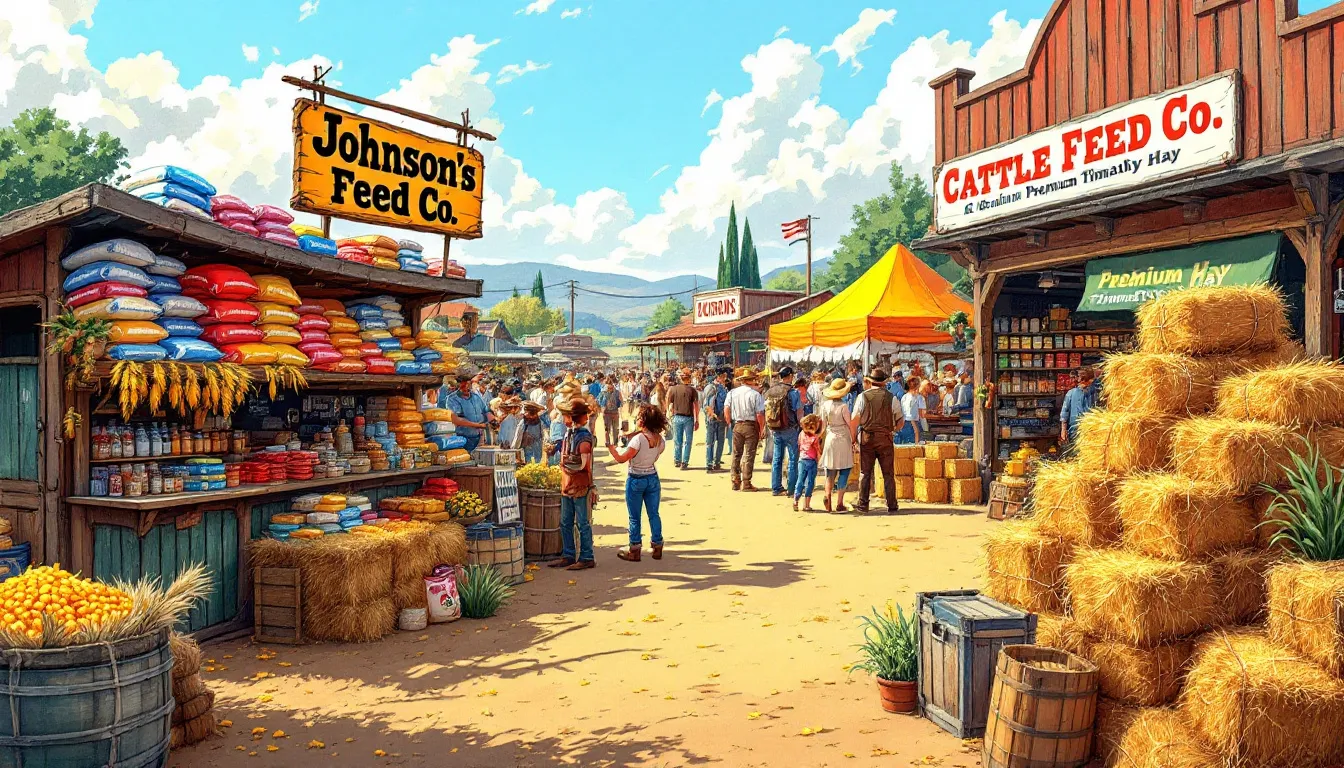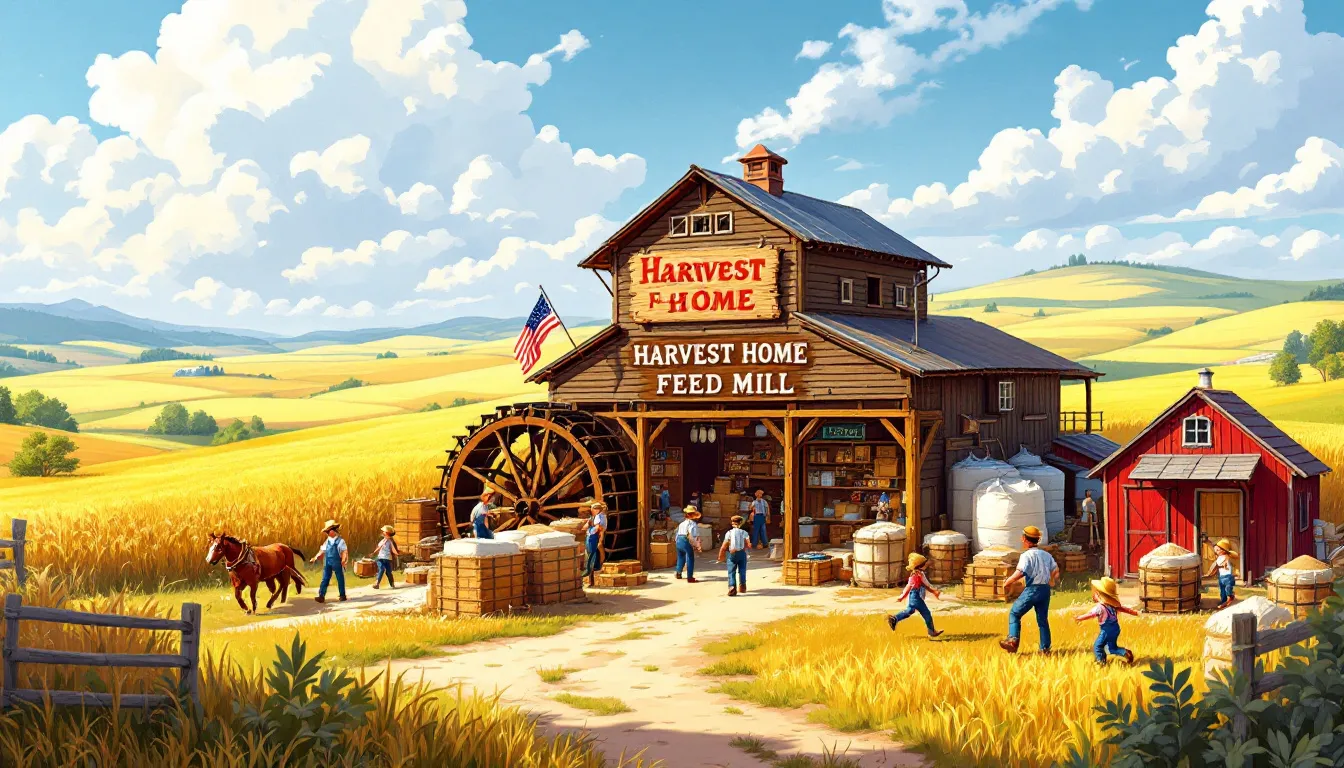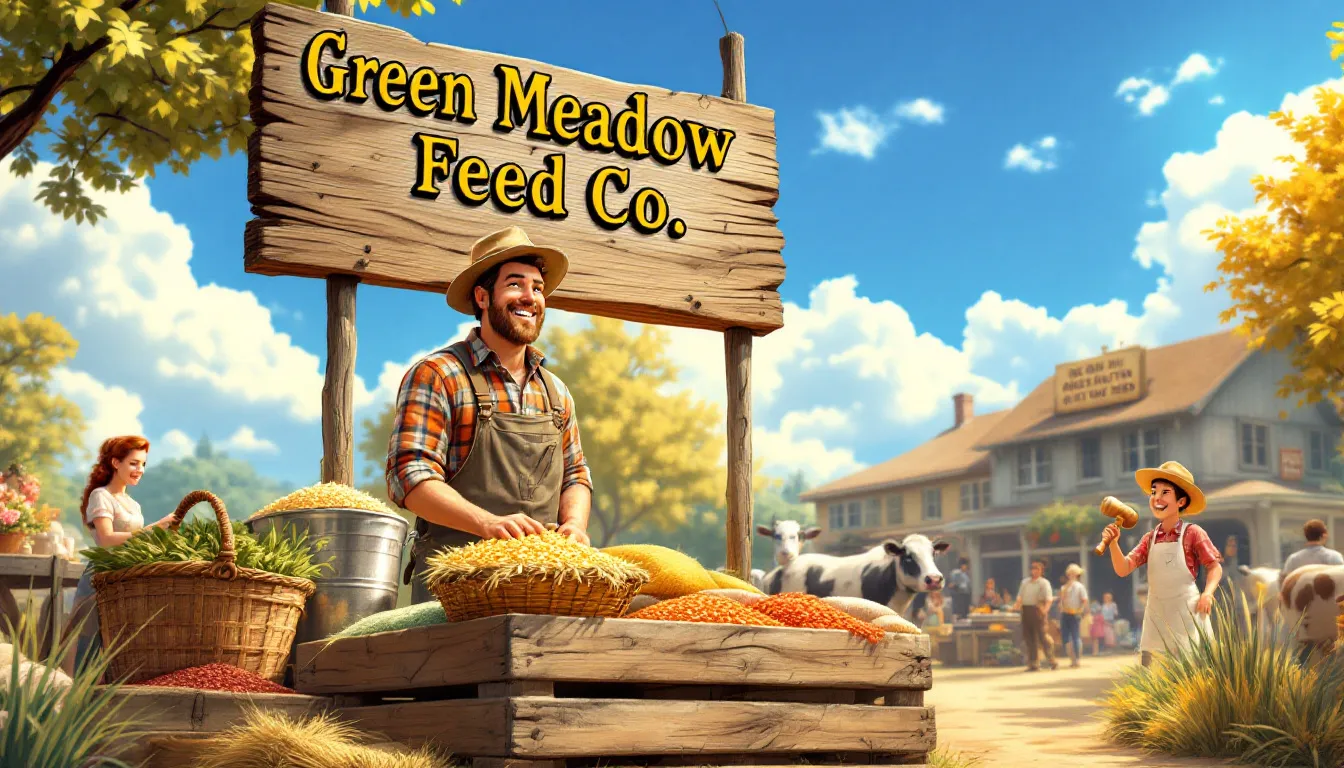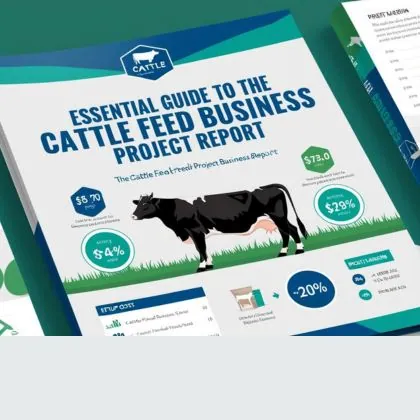Description
Interested in starting a cattle feed business in the rapidly growing animal feed industry? This comprehensive guide will show you the essentials: understanding the market, investment details, production processes, and the necessary steps to ensure success. From legal requirements to marketing strategies, we’ve got you covered.
Key Takeaways
Table of Contents
- 1 Key Takeaways
- 2 Introduction
- 3 Why Start a Cattle Feed Business in India?
- 4 Types of Cattle Feed and Their Market
- 5 Types of Cattle Feed and Their Market
- 6 Understanding the Cattle Feed Market
- 7 Essential Steps to Start a Cattle Feed Business
- 8 Creating a Cattle Feed Business Plan
- 9 Setting Up Your Cattle Feed Manufacturing Plant
- 10 Setting Up Your Cattle Feed Manufacturing Plant
- 11 Raw Materials for Cattle Feed Production
- 12 The Cattle Feed Manufacturing Process
- 13 Marketing and Selling Your Cattle Feed
- 14 Financial Planning and Profitability
- 15 Technological Advancements in Cattle Feed Production
- 16 Strategies for Growth and Expansion in Cattle Feed Business
- 17 Why You Need a Project Report
- 18 Get Your Ready-Made Cattle Feed Project Report
- 19 Summary
- 20 Frequently Asked Questions
- The cattle feed industry in India is essential for enhancing livestock productivity, with growing demand driven by the rise in animal-based food consumption.
- Starting a cattle feed business offers scalable opportunities with government support, requiring an initial investment between 7 to 15 lakhs for equipment and raw materials.
- Understanding the financial requirements for starting an animal feed manufacturing business is crucial. This includes both fixed and working capital, necessary equipment, and initial investment costs. Aspiring entrepreneurs should consider rural areas for potentially lower operational costs and available government incentives.
- Quality control, effective marketing strategies, and understanding financial dynamics are critical for the success and profitability of a cattle feed business.
Introduction
The cattle feed industry in India is a vital component of the agricultural sector. It plays a crucial role in enhancing the productivity and health of dairy and livestock farming, which are integral to the country’s economy. Quality cattle feed ensures that livestock receives essential nutrients, leading to better milk and meat production.
As the world population continues to grow, the demand for animal-based food products is on the rise. This trend underscores the necessity for nutritious and balanced animal feed, making the cattle feed business a lucrative and essential venture for aspiring entrepreneurs. Additionally, establishing an animal feed manufacturing plant involves understanding legal registrations, investment requirements, and managing capital expenditures and operational costs, which are crucial for profitability in this growing industry.
Why Start a Cattle Feed Business in India?

Starting a cattle feed business in India offers numerous advantages:
- Growing Demand: The increasing demand for dairy and livestock products drives the need for high-quality cattle feed, creating a stable market.
- Scalable Business Model: The cattle feed business model is accessible and scalable, allowing entrepreneurs to start on a small scale and expand as they gain market share.
- Government Support: The central government supports this industry through various schemes and loans, such as those offered by NABARD, facilitating easier business initiation.
- Rising Opportunities for Animal Feed Manufacturing Companies: Establishing an animal feed manufacturing company presents rising opportunities due to the increasing demand for beef and dairy products. Entrepreneurs must consider legal registrations and permits to enter this rapidly growing industry, which is essential for meeting global demand.
- Significant Role in Agriculture: Livestock farming is a major part of India’s agricultural landscape, and a well-structured cattle feed business plan can lead to substantial profits.
- Supportive Policies: Supportive government policies enhance the attractiveness of the cattle feed production business.
- Lucrative Opportunity: The combination of growing demand, supportive policies, and a scalable business model makes it an attractive venture for entrepreneurs.
Types of Cattle Feed and Their Market

Types of Cattle Feed and Their Market
- Mash Feed: Easy to produce and cost-effective. Popular among small scale cattle feed businesses due to its simplicity in production.
- Cattle Feed Pellets: Offers higher nutritional value. Convenient for storage and transportation, making it ideal for large-scale operations.
- Total Mixed Ration (TMR): Combines various ingredients to provide a balanced diet. Particularly beneficial for dairy cattle, ensuring they receive essential nutrients in the right proportions.
- Market Trends: Growing preference for high-quality, nutritionally balanced cattle feed. Increasing awareness among farmers about advanced feeding systems. Rising demand for innovative feed formulations and products.
- Opportunities: Expanding market due to the increasing demand for diverse cattle feed types. Potential for growth in the global cattle feed market by offering unique and high-quality products.
Understanding the Cattle Feed Market
- Significant Growth Potential: The cattle feed market is experiencing notable growth due to the rising demand for animal-based food products within the animal feed market. Animal feed production plays a crucial role in meeting this growing demand by ensuring the supply of safe and high-quality livestock products.
- Projected Market Size: The global cattle feed market is expected to reach approximately $108.2 billion by 2030, with an annual growth rate of 3.7%.
- Demand Drivers: This growth is driven by the increasing global consumption of meat and dairy products.
- Indian Market Expansion: In India, the cattle feed industry is rapidly expanding, with dairy cattle being the largest market segment.
- Rising Demand in India: The demand for milk and meat is escalating, prompting farmers to focus on cattle health and productivity, further driving market growth.
- Asia-Pacific Region: The Asia-Pacific region accounts for 45% of the global market, with urban middle-class meat consumption significantly influencing this expansion.
- Entrepreneurial Opportunities: The cattle feed business offers lucrative opportunities for entrepreneurs due to the ongoing rise in global meat consumption and dairy product demand.
- Market Dynamics: Understanding these market dynamics is crucial for developing a successful cattle feed business plan.
Market Potential and Strategy
The cattle feed market has immense potential for growth and expansion. With the increasing demand for animal products, the need for high-quality cattle feed is on the rise. The market is expected to grow at a compound annual growth rate (CAGR) of 15% between 2021 and 2026, reaching a size of nearly INR 933.3 billion. The Indian livestock sector is a major employer of cattle feed products, driving economic growth. The country’s livestock sector is a major employer of cattle feed products to sustain and retain the dairy industry.
To tap into this growing market, it is essential to create a comprehensive cattle feed business plan. The plan should include market research, financial projections, and a detailed analysis of the competition. It should also outline the production process, including the sourcing of raw materials, manufacturing, and packaging. By understanding the market dynamics and strategically planning your business operations, you can position your cattle feed business for success in this expanding market.
Essential Steps to Start a Cattle Feed Business

Starting a cattle feed business involves several critical steps to ensure success:
- Conduct Market Research: Analyze demand, competition, and market trends in your target area to understand the cattle feed market dynamics.
- Develop a Business Strategy: Create a unique and effective business strategy to differentiate your business and outline your path to success.
- Prepare a Business Plan: Formulate a comprehensive business plan that includes revenue projections, market share estimates, and clear business objectives. A comprehensive business plan is crucial for a cattle feed manufacturing business, as it outlines the necessary machinery, equipment, and market trends to capitalize on the growing demand for high-quality animal feed.
- Investment Planning: Determine the initial investment required, typically ranging from 7 to 15 lakhs, for equipment, raw materials, and setting up the manufacturing facility.
- Legal Compliance: Obtain necessary legal registrations and permits, including company registration, MSME registration, BIS certification, and trademark registration.
- Secure Funding: Explore funding options such as bank loans or government schemes to support your investment needs.
- Select a Location: Choose an optimal location for your manufacturing plant, considering proximity to raw materials and target markets.
- Purchase Equipment: Invest in essential machinery and equipment for efficient cattle feed production, ensuring quality and productivity.
- Source Raw Materials: Secure high-quality raw materials like wheat bran, maize, and vitamin mixes for nutritious cattle feed production.
- Establish Distribution Channels: Develop a robust distribution network to ensure timely delivery of products to your target customers.
- Implement Marketing Strategies: Utilize both digital and traditional marketing methods to promote your cattle feed products and reach a wider audience.
- Focus on Quality Control: Implement stringent quality control measures to maintain high standards and ensure customer satisfaction.
- Monitor Financial Performance: Regularly review financial metrics to ensure profitability and make informed business decisions.
By following these steps, you can establish a successful cattle feed business that meets market demands and supports livestock farming effectively.
Creating a Cattle Feed Business Plan
A cattle feed business plan is essential to demonstrate the framework of setting up a profitable cattle feed production business. The plan should include the following components:
- Executive Summary: A brief overview of the business, including the mission statement, products, and target market. This section should capture the essence of your business and its goals.
- Market Analysis: An analysis of the market, including the demand for cattle feed, competition, and market trends. Understanding the cattle feed market dynamics will help you identify opportunities and threats.
- Production Process: A detailed description of the production process, including the sourcing of raw materials, manufacturing, and packaging. This section should outline the steps involved in producing high-quality cattle feed.
- Financial Projections: Financial projections, including income statements, balance sheets, and cash flow statements. These projections will help you understand the financial viability of your business and attract potential investors.
- Management and Organization: A description of the management structure and organization of the business. Highlight the roles and responsibilities of key personnel to ensure efficient business operations.
By including these components in your cattle feed business plan, you can create a clear roadmap for your business and increase your chances of success in the cattle feed production business.
Setting Up Your Cattle Feed Manufacturing Plant

- Legal Registrations and Investment Requirements: When setting up a cattle feed manufacturing plant, it is crucial to understand the necessary legal registrations and investment requirements. Establishing an animal feed manufacturing business involves obtaining various licenses and permits, ensuring compliance with local regulations, and making significant capital investments. This includes costs related to equipment, facilities, and operational expenses.
Setting Up Your Cattle Feed Manufacturing Plant
- Location Selection: Choose a strategic location for operational efficiency. Consider rural areas for affordable land and proximity to farms. Ensure good transport links for efficient distribution.
- Machinery and Equipment: Invest in essential machinery like ribbon blenders, pulverisers, and packaging machines. Ensure a steady supply of utilities like electricity and water. Partner with reliable machinery suppliers for high-quality equipment.
- Facility Layout and Design: Design an efficient layout to enhance productivity and safety. Minimize waste and ensure compliance with safety and regulatory standards. Optimize workflow to boost operational efficiency and productivity.
- Regulatory Compliance: Adhere to safety and regulatory standards throughout the plant setup. Implement pollution control measures to comply with environmental regulations.
- Quality Control Measures: Use testing equipment to maintain machine performance and product quality. Implement stringent quality control measures to ensure high standards.
By focusing on these key aspects, you can establish a successful cattle feed manufacturing plant that supports efficient production and meets market demands.
Personnel and Equipment
The cattle feed business requires specialized personnel and equipment to ensure efficient and effective production. The following personnel are required:
- Production Manager: Responsible for overseeing the production process, including the sourcing of raw materials, manufacturing, and packaging. The production manager ensures that the production process runs smoothly and efficiently.
- Quality Control Manager: Responsible for ensuring the quality of the cattle feed, including testing and inspection. The quality control manager implements stringent quality control measures to maintain high standards.
- Marketing Manager: Responsible for promoting the business and selling the cattle feed. The marketing manager develops and implements marketing strategies to increase product visibility and sales.
The following equipment is required:
- Blenders: Used to mix the raw materials and create the cattle feed. High-quality blenders ensure a uniform and consistent mix.
- Machines: Used to manufacture the cattle feed, including pelletizers and extruders. Investing in advanced machinery can increase production efficiency and product quality.
- Packaging Equipment: Used to package the cattle feed, including bagging and labeling machines. Proper packaging equipment ensures that the cattle feed is stored and transported safely.
By investing in specialized personnel and high-quality equipment, you can ensure the efficient production of high-quality cattle feed, meeting market demands and supporting livestock health.
Raw Materials for Cattle Feed Production
- Wheat Bran: Provides essential fiber and nutrients, crucial for cattle digestion and health.
- Groundnut Cake: A rich source of protein and energy, enhancing livestock productivity.
- Maize: Offers 8-10% protein and 60% total digestible nutrients, vital for cattle growth and development.
- Rice Bran Extract: Contains essential fatty acids and vitamins, supporting overall animal health.
- Vitamin and Mineral Mix: Ensures a balanced diet, providing essential nutrients for optimal livestock performance.
- Sourcing Strategy: Bulk purchasing during harvest seasons helps secure competitive prices and maintain a steady supply.
- Storage Solutions: Utilize silos and proper storage techniques to preserve raw material quality and nutritional value.
The Cattle Feed Manufacturing Process
The cattle feed manufacturing process involves several critical steps to ensure the production of high-quality and nutritious feed. Here is a detailed pointwise explanation:
- Raw Material Procurement: Source essential raw materials such as wheat bran, maize, rice bran extract, and vitamin mixes to ensure quality feed production.
- Weighing and Mixing: Carefully weigh and mix the raw material powders to achieve a uniform blend, adding vitamins and minerals for balanced nutrition.
- Pelletizing: Feed the homogeneous mixture into a pellet mill to shape it into pellets, which facilitates easy storage and transport.
- Extrusion: Extrude the mixture to form the final pellet shape, ensuring consistency in size and quality.
- Quality Control: Implement rigorous testing of raw materials and the final product to maintain nutritional standards and safety using advanced equipment.
- Packaging: Package the finished pellets to preserve quality and freshness, readying them for distribution.
- Distribution: Establish efficient distribution channels to ensure timely delivery and a steady supply to your target markets.
By adhering to these steps, you can ensure the efficient production of cattle feed that meets market demands and supports livestock health.
Marketing and Selling Your Cattle Feed

- Develop a Comprehensive Marketing Plan: A well-structured marketing plan is essential for the success of your cattle feed business. Tailor your products and strategies to meet the preferences and needs of livestock farmers, ensuring effective marketing.
- Identify Target Markets: Pinpointing your target markets is crucial. Focus on livestock farmers and animal husbandries, as they are the primary customers for cattle feed businesses. Segment the market by livestock type, farm size, and geographic location to customize your marketing strategies.
- Implement Effective Marketing Strategies: Educate farmers about the benefits of compounded cattle feed to increase adoption of new feeding practices. Employ a mix of digital marketing and on-ground approaches to optimize product distribution and reach a broader audience.
- Utilize Digital Marketing: Leverage SEO and social media engagement to enhance your brand’s visibility and customer reach. Digital marketing strategies are vital for expanding your customer base and promoting your products.
- Build Partnerships: Establish partnerships with local feed stores and agricultural cooperatives to enhance market presence. These collaborations can improve product distribution and customer engagement.
- Establish Efficient Distribution Channels: Develop robust distribution channels to ensure timely delivery of your cattle feed products. Use both online and offline channels to reach target customers effectively.
By focusing on these strategies, you can effectively market and sell your cattle feed products, ensuring business growth and success in the competitive cattle feed industry.
Financial Planning and Profitability
- Importance of Financial Planning: Essential for a successful cattle feed business, enabling strategic growth and capacity expansion in the cattle feed market.
- Production Cost Analysis: Key cost components include raw materials, machinery, and operational expenses. Understanding these helps in setting competitive pricing.
- Revenue Projections: Regularly update revenue forecasts to align with market trends, ensuring your business remains competitive and meets its objectives.
- Profit Margins: The cattle feed business offers good profit margins due to steady demand. Monitoring market trends and production efficiency is crucial for sustaining profitability.
- Understanding Costs: For instance, maize cattle feed production costs Rs 3750 per ton, while barley cattle feed market price is Rs 17466. Analyzing these figures aids in maintaining profit margins.
- Market Growth Trends: Stay informed about market dynamics to adapt financial strategies accordingly and capitalize on growth opportunities.
By focusing on these aspects, you can ensure your cattle feed business remains financially viable and profitable.
Technological Advancements in Cattle Feed Production
- Precision Nutrition: Tailors the nutritional content of cattle feed to meet the specific dietary needs of livestock, enhancing feed efficiency and animal health.
- Sustainable Ingredients: Adoption of eco-friendly and sustainable ingredients, addressing environmental concerns and promoting sustainable production practices in the cattle feed industry.
- Alternative Protein Sources: Incorporation of alternative protein sources, such as plant-based proteins, to reduce reliance on traditional feed ingredients and improve sustainability.
- Automation and Machinery: Utilization of advanced machinery and automation in feed production to increase efficiency, reduce labor costs, and ensure consistent product quality.
- Data Analytics: Implementation of data analytics to optimize feed formulations, monitor livestock health, and improve overall feed management strategies.
- Innovative Feed Additives: Development of new feed additives that enhance cattle growth, digestion, and immunity, contributing to improved livestock productivity.
- Smart Farming Technologies: Integration of smart farming technologies, such as IoT and sensors, to monitor feed consumption and livestock behavior, enabling data-driven decision-making.
- Enhanced Quality Control: Use of advanced testing equipment and quality control measures to maintain high standards and ensure the nutritional value of cattle feed products.
By embracing these technological advancements, the cattle feed production business can achieve efficient production, meet market demands, and contribute to the well-being of livestock farming.
Strategies for Growth and Expansion in Cattle Feed Business
To achieve growth and expansion in the cattle feed business, the following strategies can be employed:
- Market Research: Conduct market research to identify new markets and opportunities. Understanding market trends and customer needs can help you tailor your products and marketing strategies.
- Product Development: Develop new products, including organic and specialty cattle feed. Innovation in product offerings can help you meet diverse customer needs and stand out in the market.
- Marketing and Promotion: Promote the business and products through advertising, trade shows, and other marketing strategies. Effective marketing can increase brand awareness and attract new customers.
- Partnerships and Collaborations: Partner with other businesses, including farmers and distributors, to increase market share and reduce costs. Collaborations can enhance your market presence and operational efficiency.
- Expansion of Production Capacity: Increase production capacity to meet growing demand and reduce costs. Scaling up production can help you achieve economies of scale and improve profitability.
- Quality Control: Ensure high-quality products through regular testing and inspection. Maintaining high standards can build customer trust and loyalty.
- Customer Service: Provide excellent customer service to build customer loyalty and increase repeat business. Satisfied customers are more likely to recommend your products to others.
By employing these strategies, the cattle feed business can achieve growth and expansion, increasing market share and profitability.
Why You Need a Project Report
- Securing Financing: A project report is crucial for obtaining bank loans or government subsidies, providing detailed insights into your cattle feed business plan and financial projections.
- Clear Roadmap: It outlines a structured approach for your business operations, helping you set clear objectives and strategies to achieve them.
- Investment Attraction: A comprehensive report instills confidence in potential investors by showcasing market analysis, investment requirements, and growth potential.
- Operational Guidance: It serves as a guide for executing your business plan effectively, detailing steps for setting up and running your cattle feed manufacturing plant.
- Risk Management: Identifies potential risks and challenges, enabling you to develop strategies for mitigating them and ensuring business continuity.
- Performance Monitoring: Provides benchmarks for assessing business performance and making informed decisions to enhance profitability and sustainability.
- Legal Compliance: Ensures adherence to legal and regulatory requirements, protecting your business from potential legal issues.
Get Your Ready-Made Cattle Feed Project Report
- Comprehensive Coverage: Our ready-made cattle feed project report includes essential segments such as market analysis, investment requirements, legal compliance, and financial projections.
- Investor Confidence: Instills confidence in potential investors or loan authorities by providing detailed insights into your cattle feed business plan.
- Customization: Easily customize the report to fit your specific business needs, ensuring it aligns with your unique objectives and strategies.
- Quick Download: Download the report quickly to save time and expedite the process of starting and growing your cattle feed business.
- Solid Foundation: Provides a strong foundation for your entrepreneurial journey, equipping you with the necessary tools and information for success.
- Business Growth: Facilitates the growth of your cattle feed business by offering a well-structured roadmap and operational guidance.
- Start Your Journey: Download now to embark on your entrepreneurial journey with confidence, knowing you have a detailed and reliable project report to guide you.
Summary
In summary, starting a cattle feed business in India offers significant opportunities for growth and profitability. From understanding the market and investment requirements to setting up your manufacturing plant and implementing effective marketing strategies, this guide provides comprehensive insights into every aspect of the business.
By following these steps and utilizing the provided resources, you can establish a successful cattle feed business that not only meets the growing demand for quality feed but also contributes to the well-being of livestock and the agricultural sector. Embark on this journey with confidence and make a positive impact on the livestock farming industry.
Frequently Asked Questions
What are the initial investment requirements for starting a cattle feed business?
To start a cattle feed business, an initial investment of approximately 7 to 15 lakhs is required for equipment and raw materials. It’s essential to plan your budget accordingly to ensure a successful launch.
What legal registrations are necessary for a cattle feed business?
For a cattle feed business, it is necessary to have company registration, MSME registration, BIS certification, and trademark registration. These registrations ensure compliance and protect your business legally.
What are the key raw materials required for cattle feed production?
The key raw materials required for cattle feed production include wheat bran, maize, rice bran extract, and a vitamin and mineral mix. These ingredients are essential for ensuring the health and productivity of cattle.
How can I market my cattle feed products effectively?
To market your cattle feed products effectively, focus on educating farmers, leveraging digital marketing, and establishing partnerships with local cooperatives. These strategies will enhance your product visibility and foster stronger customer relationships.
Why is a project report important for my cattle feed business?
A project report is essential for your cattle feed business as it helps secure loans and effectively plan and execute your business strategy. It serves as a vital tool for presenting your objectives and operational framework to potential investors and stakeholders.
